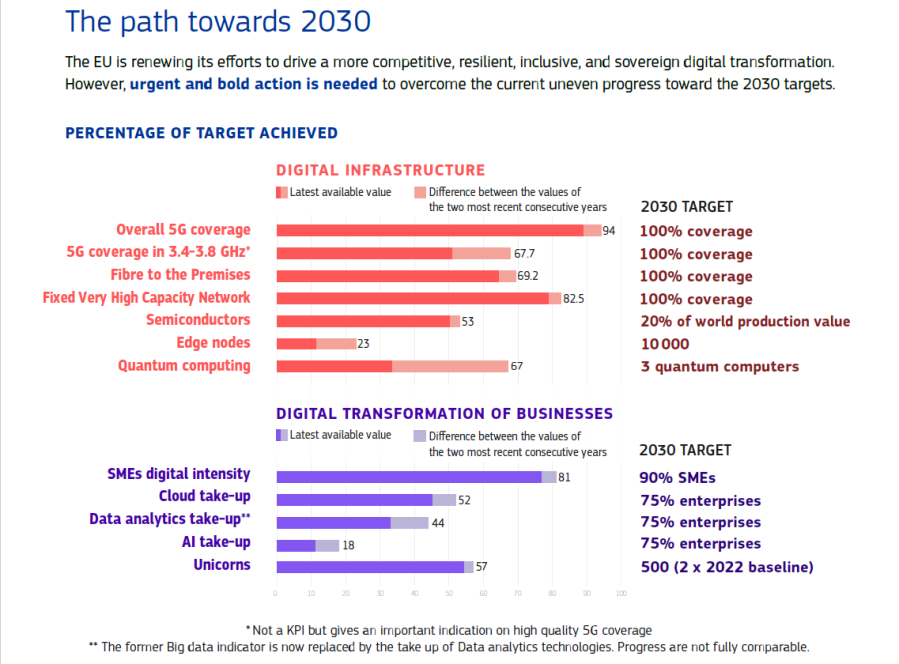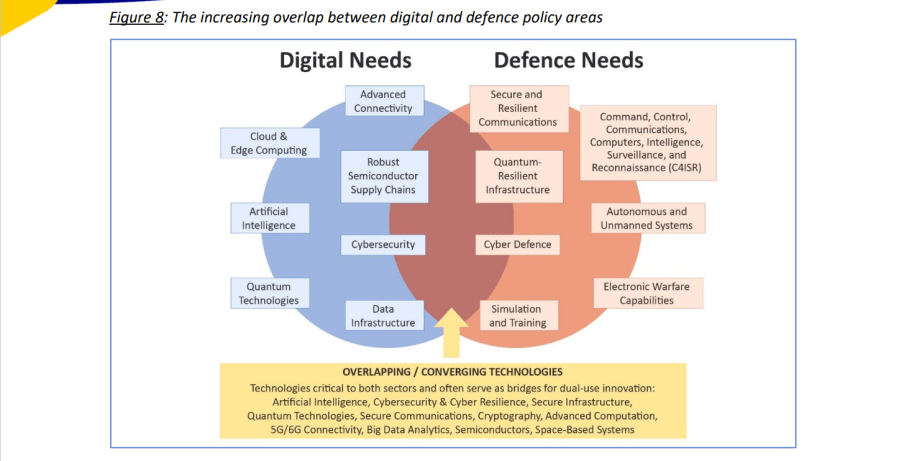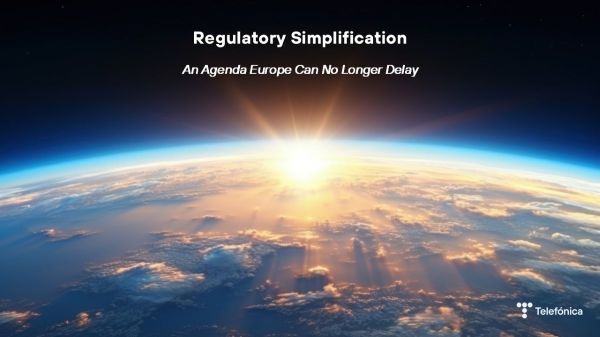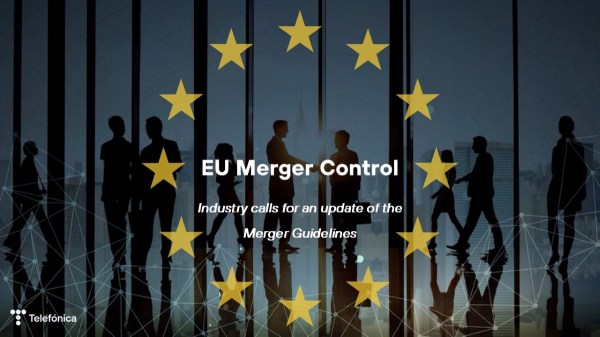State of the Digital Decade 2025
On 23 June, the European Commission published its annual report on the state of implementation of the digitalisation objectives agreed by the European Institutions in 2022. These objectives are known as the Digital Decade targets for 2030. Within the same strategic programme, a monitoring and cooperation mechanism was established to achieve the objectives and targets set for Europe’s digital transformation.
This latest report from the European Commission provides a comprehensive overview of the EU’s progress toward its 2030 digital goals, highlighting both achievements and persistent gaps in areas such as 5G deployment, artificial intelligence (AI) adoption, digital skills and strategic technological sovereignty.
The report acknowledges that, despite notable progress in the digitalization of public services and data infrastructure, the EU continues to face challenges including energy constraints, digital skills shortages and external dependencies in critical technologies such as AI and semiconductors.
According to the report, we are at a critical juncture to accelerate action to achieve the goals. The report encourages investment in strategic areas such as secure connectivity, cloud and quantum technologies to help the EU strengthen our competitiveness and safeguard sovereignty.
Hower, the real problem is that European networks are not ready to offer these services. While efforts across the EU have increased, the report stresses the need for greater public and private intervention and investment to enhance the EU’s technological capacity, improve infrastructure, and develop digital skills. But one must ask whether more fundamental changes are needed to achieve these goals. In my view, it is vital to reform regulation to enable, not penalize, investment. Ex-ante regulation should not be the default in the European telecommunications sector. Year after year, this report shows that while Europe takes small steps, other regions of the world are making leaps forward.
Connectivity in Europe: too slow to compete
Very high-capacity fixed network (VHCN) coverage reached 82.5%, a growth rate of 4.9%, while fibre coverage reached 69.2% of households, with an annual increase of 8.4%. However, the report acknowledges that, at the current pace, full coverage will only be achieved by 2051. Yes, you heard that right – the year 2051; it’s not a typo.
And what about mobile networks? Well, the report says that 5G adoption (percentage of population using 5G SIM cards) increased in the EU from 21.7% to 35.6%. This is higher than India’s 11.1%, but still far behind the US at 96.5% and China at 73.1%.
In 2025, Europe is significantly lagging behind in the adoption of 5G stand-alone (SA) networks, with only 2% of 5G users connected via 5g stand-alone infrastructure compared to the 24% in the US and 77.1% in China.
In short, and according to the European Commission’s own data, Europe is unfortunately not playing in the top technological league.

Cloud and edge capabilities: Europe’s great challenge to avoid being left behind
It is alarming to read that the report foresees the cloud computing capacity gap between Europe and other competitors such as the US and China will widen unless significantly more capital is allocated to the expansion of edgeand cloud computing capabilities. It also identifies more specific mismatches between digital priorities and the funding allocated through EU public instruments, showing in particular that little attention is paid to overall objectives and digital principles, skills development, core technologies, deployment of gigabit connectivity infrastructure and digitisation of SMEs.
In this context, their main recommendation is to focus and align public spending as much as possible with strategic priorities and to maximise its impact and efficiency.
Digital sovereignty: a strategic necessity for European security
While global access to innovative and affordable technology, infrastructure and services is vital for the EU’s competitiveness, its dependence on foreign digital technologies, infrastructure and services exposes it to a number of risks. While digitalisation drives innovation, productivity and global competitiveness, persistent strategic dependencies threaten the EU’s economic security and technological sovereignty. These overdependencies are particularly acute in the areas of semiconductors, cloud, data infrastructure and cybersecurity technologies.
Robust and secure communication networks are essential for modern defence operations. Sovereign satellite communications infrastructure is vital for independent defence and crisis response. The integration of 5G and 6G technologies will further enhance secure and real-time operational capabilities in all domains.
In parallel, sovereign cloud networks are crucial to ensure that sensitive defence data is securely stored, processed and protected within EU jurisdiction. AI represents a transformative force in both civilian and military contexts, as AI-based systems are key to accelerating threat detection, improving decision-making and supporting autonomous operations.

Digitalisation and sustainability: a key pairing for Europe in 2030
The report highlights that digitalisation and environmental sustainability are no longer parallel priorities, but mutually reinforcing transformations. If effectively implemented, digital solutions could reduce global greenhouse gas emissions by 15-20% by 2030, especially by improving efficiency in the construction, energy, transport and manufacturing sectors.
This digital-sustainable nexus also improves Europe’s industrial competitiveness. More sustainable digital infrastructure and smart technologies reduce operational costs and encourage consumer adoption. The integration of AI and the Internet of Things into energy and resource management enables more efficient operations, especially for SMEs and municipalities. This contributes to decarbonisation, while strengthening Europe’s position in emerging green technology markets. Digital tools not only optimise supply chains, but also enable circular and profitable business models (such as product-as-a-service).
Digitalisation for smart greening is key to increasing Europe’s strategic autonomy and resilience. Digital tools, such as smart metering, enable better management of energy demand and currently cover about 60% of European households on average. However, significant disparities remain between EU Member States. As demand grows for low-carbon infrastructure and advanced computing, control over key technologies such as semiconductors, secure data infrastructure and energy-efficient data centres has become a crucial factor in reducing strategic dependencies
The report reveals the serious technological and digital shortcomings we face in Europe. Digitalisation is essential both for developing the welfare society and for improving the competitiveness of the economy. Therefore, while the measures proposed in the report to improve both connectivity and digitalisation are positive, they still need to be far more ambitious. The Digital Networks Act is expected by the end of the year, and this proposal must mark a complete shift if we are to meet and even surpass the targets set out in the Digital Agenda for 2030. A regulatory framework focused primarily on investment and ensuring a level playing field across the entire digital ecosystem will be crucial. Otherwise, the “Digital Gap” will continue to widen in future annual reports.








